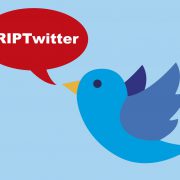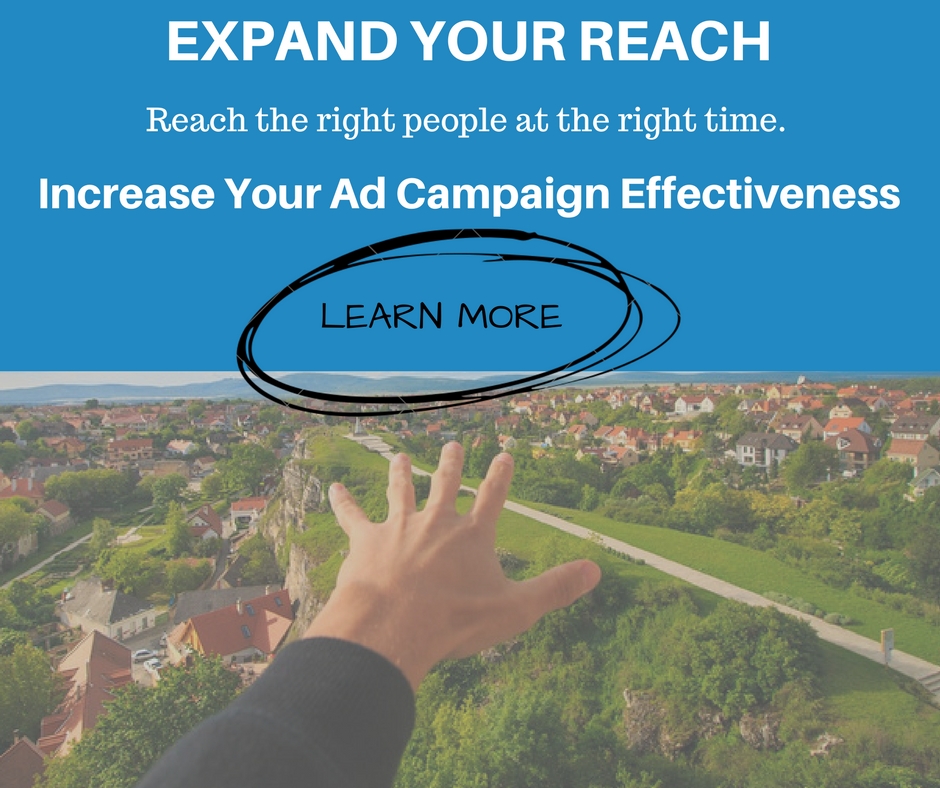Want to Improve Your Digital Marketing? Check Out What Your Competitors are Doing
/0 Comments/in marketing, trending/by 495digitalMavericks owner and tech billionaire Mark Cuban has a book entitled “How to Win at the Sport of Business,” whereas he parallels the competitive spirit within an industry to that of a baseball or basketball game. While there are major differences between those two ideas, the point is the same: Business is a competition, and in order to win, you have to know and beat your opponent.
In years past, one of the primary ways that businesses would try to one-up each other is through price. Lower the price, and your competitors will naturally gravitate towards you. That’s not the case anymore; if you want to pull ahead, you have to not only understand what products and services your competitors are promoting but how they’re promoting it as well. This involves everything, from your branding to your customer service to your mission statement and everything in between.
Since strong competition is one of the major causes of a business failing, you’ll have to pay attention to who you’re positioned next to in search results and paid advertising. How do you do that? Simple.
 1. Learn About Your Opponents
1. Learn About Your Opponents
In the beginning of your company life cycle, you may be all alone in your niche. Either you’re the only one selling a particular product, or you’re the only one solving a particular problem. Eventually, though, other people will take notice and begin to come after your clientele. In fact, only one-third of businesses are still in existence a decade after they open up the doors. If you want to make sure you’re not part of that statistic, you have to keep your eyes open to the playing field.
In the digital sphere, your competitors are the ones that are positioned next to you in the SERP’s (Search Engine Results Page) or are the ones seeking to solve the same problem that your product or service does. If there’s no major competitors, that’s great, but use the time to shore up your branding and position yourself as a perennial market leader. If you do notice that others are beginning to encroach on your territory, start studying their practices and taking notes.
2. Exploit Their Weaknesses
Once you’ve studied your competitors thoroughly, you need to start looking for vulnerabilities in their marketing that you can exploit. Below are a few places to look specifically:
Links: Do they have broken links all over their webpage? Are they working on developing backlinks? Do they have any backlinks at all? If not, this could be an excellent place to start.
Social Media: Though most businesses have caught up to the idea that they need to be active on social media, not every business is doing this effectively. Customer engagement is a big part of this, and if your competitors aren’t doing it, emphasize that with your customers.
SEO: Are your competitors up to date on the latest SEO best practices? Make a list of their on and off-page SEO metrics and compare them to your own, including local SEO as well.
Conversion Rate: Look at their landing pages and advertisements and notice their copy. What are they missing? What could you offer that’s better?
Conclusion
Learning from your competitors isn’t rocket science, but in order to pull ahead in the market for your specific niche, you have to study your opponents and take advantage of every opportunity that’s presented to you. Competitors may be out to take some of your customers away from you, but that doesn’t mean they can’t be a force for good either.
6 Digital Marketing Hacks the Competition is Using to Steal Your Customers
/in marketing, trending/by 495digital Business competition is nothing new. Ever since the dawn of business, similar companies have been using various tactics to outsmart their competition and gain an edge over them. This is no less true today in the digital marketing arena.
Business competition is nothing new. Ever since the dawn of business, similar companies have been using various tactics to outsmart their competition and gain an edge over them. This is no less true today in the digital marketing arena.
It is not just about edging out your competition by pricing, better products, or sales manipulations in today’s online advertising world, but by redirecting your competitor’s customers using sneaky, but ethical, digital marketing techniques. Techniques that, if not known, are giving an unfair advantage to your competition as they siphon and sift your potential customers away from you.
The following 6 digital marketing hacks will teach you how to tap into your competitor’s online lifeline and shift their customer streams into your business instead.
Hack #1: Google Ads & Your Competitor’s Most Valuable Keywords
Google search terms are a boon to any business that advertises online, especially those that use the Google Adwords platform to target specific keywords.
As Google is the most visited website in the world, it can give companies advertising on its paid platform an almost endless supply of potential customers. That is if advertised in the right way.
Many companies use “branded keywords,” such as the names of their competitors to attract visitors via Google Ads.
This technique is simple and effective and takes a lot of the guesswork out of keyword research. Not to mention it saves the advertiser a lot of money in the process.

Hack #2: Gmail Ads & Branded Keywords
Similar to the above hack, this method differs slightly in that you will use the Gmail interface instead of the Google Search page to target your competitor’s branded keywords.
Gmail Ads work in much the same way as Google Ads do but usually appear on the top of the most recent email list.
By targeting your competitor’s branded keywords via Gmail Ads, you can put your business in front of millions of Gmail users who have searched for or asked to receive emails from your competitors.
 Hack #3: Facebook Ads, Competitor Brand, & Interests
Hack #3: Facebook Ads, Competitor Brand, & Interests
Facebook makes it very easy to do so as long as you know who your competitors are.
Using the Facebook Ad platform you can choose your competitor’s brand name under the interests section and get your ads displaying in front of those who have shown an interest in your competitors.
For example, if you are selling supplements online, you might want to choose Bodybuilding.com as a target interest to get your ads shown to Facebook users who like and/or visit this specific website.
Hack #4: YouTube & TruViews
Very similar to the above-mentioned methods, you can use YouTube’s TrueView advertising to target your competitors’ videos by running video ads of your own over theirs.
Your ad will appear right before their video does and you will get the first chance to show what you have to offer before your competition does.
It seems almost illegal to do such things, but it is totally legal to do so according to YouTube policies. Again, all you really need is to know who your competitors are and how to create your video in such a way as to attract the viewer’s attention to your offer and away from your competition.
Hack #5: Twitter Ads To Target Your Competitors Followers

Everyone talks about Google, Facebook, and YouTube as the best digital advertising mediums these days, but most businesses dismiss the other 600-pound gorilla in the room – Twitter.
With over 300 million monthly users Twitter is no advertising joke. Studies have shown that over 40% of these 300 million users are following some brand or another.
If you know your competitor’s Twitter accounts, you can target their followers through the Twitter Ads platform. What is more, there are many tools like Audiense, Twitonomy, and FollowerWonk that allows you to download the usernames and profiles of your competitor’s followers into a streamlined format.
After you have downloaded these names, all you have to do is upload the usernames in the “Tailored Audience” section of the Twitter Ads platform and voila, you have got your message in front of your competitor’s audience.
 Hack #6: Dissatisfied Twitter Followers (Free Method)
Hack #6: Dissatisfied Twitter Followers (Free Method)
The above methods are fine if you have money to spend on advertisement, but this hack works even if you have very little to spend or no money at all.
The only caveat to this hack is that your competitors must have a Twitter channel that handles support issues. Many of the big names do.
Once you have located your competitor’s support channels on Twitter, you can view each complaint and target ads using the Twitter Ad platform to reach out to each and every frustrated customer, offering them sympathy and guidance on how to deal with the situation (hint: how your business can help if they give it a try).
To make it easier on yourself, simply follow your competitor’s support channel to receive immediate complaint registrations and act on them before they get resolved.
Conclusion
If you are not using these digital marketing strategies to get in front of your competitor’s audiences, then you can be sure that many of them are using these same hacks to steal yours.
Therefore, put these strategies into play today and see how your customer base increases each and every day.

#RIPTwitter — How the Social Network Dug its Own Grave
/in social, trending/by 495digital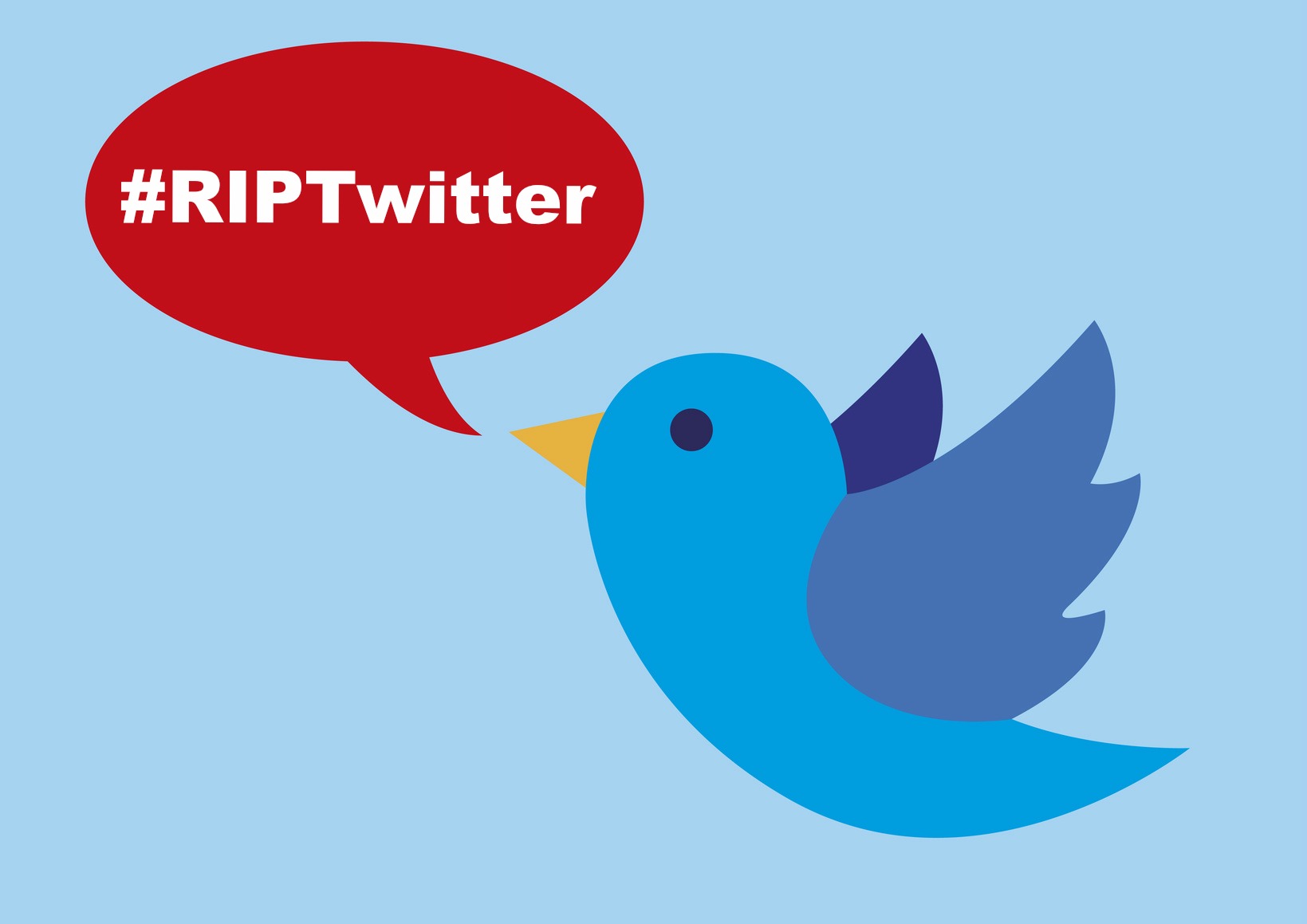 Many social media users believe Twitter is on its way out. It’s an idea that’s actually been around for a while, despite the platform having hundreds of millions of users each month at present. However, it’s not so much Twitter that’s dying as it is the Twitter the developers imagined.
Many social media users believe Twitter is on its way out. It’s an idea that’s actually been around for a while, despite the platform having hundreds of millions of users each month at present. However, it’s not so much Twitter that’s dying as it is the Twitter the developers imagined.
What the Makers of Twitter Wanted
At first, Twitter was precisely what its creators imagined it could be. Everyone use their accounts to interact not only with one another, but their favorite celebs, product lines, and more. For about six years, from 2006 to 2012, the platform was the hub of social media.
What It is Now
Nowadays, interaction with tweets is much lower. Many celebs with some high follower counts have openly said they don’t use Twitter anymore, leaving potentially thousands of followers stranded. Connecting with industry stars was one of the cornerstones of the original Twitter.
What is Happening With Twitter?
There is no one reason why Twitter is shrinking, but there are a few things that factor into its waning popularity.
 1. Online Trolling
1. Online Trolling
Your Twitter fans can sour in an instant. If you tweet the ‘wrong’ message or share an idea that your followers do not like, there’s a chance that some of them might even turn hostile. This can even lead to messages that are nothing more than personal insults.
2. Anonymity is Simple
It’s no surprise that one of the reasons online bullying exists on any platform is how easy it is to hide oneself. Anonymity is like the anti-Kryptonite of the internet troll, giving him or her the power to be anything they want without consequences. Because Twitter only requires an email address and no identifying info, it’s easy to pass yourself off as someone or something else entirely. Unlike other social media platforms, Twitter doesn’t require that its users state their real names for their terms of service agreement.
3. Multiple Accounts
You can have unlimited accounts on Twitter. Certainly, some people or companies may need more than one account, but this ability means the platform is ripe for abuse. Even trolls that are banned from Twitter can just come back under a new account.
4. Following Too Many Accounts
Each new Twitter account can follow up to 5000 other accounts. The biggest problem with these generous limits is the creation of bot accounts. We know that the visibility of a particular Tweet goes down after only 18 minutes. That means if I want to Tweet something I know my followers will see, I’ll have to do it every 18 minutes for days at a time. A bot account will do this without the user having to do anything like interacting.
5. Bots Have Taken Over
Dozens of fake accounts can tweet and retweet without any input from the actual user. Some automation is helpful for those of us who want to link articles we publish to our Twitter feeds or update our blogs. I am talking about a more insidious type of automation. Bots can follow thousands of others, send out more Tweets in a minute than any human could, and retweet content all the time.
No Easy Answer
In conclusion, Twitter’s spiral is unlikely to change. It now relies on things like bots to keep investors happy. Bots increase ad revenue and trying to eliminate them would cost both money and numbers. Executives at Twitter likely know this, and rather than fix the issue, would rather fade gracefully while profits are high.

What You Should Be Prepared to Spend on Digital Marketing in 2018
/in marketing, trending/by 495digital Gone are the days when businesses of all shapes and sizes spent the majority of their advertising dollars on traditional advertising mediums like billboards, newspapers, T.V., and radio. Now, almost all businesses regardless of their size spend most of their hard earned profits on digital marketing.
Gone are the days when businesses of all shapes and sizes spent the majority of their advertising dollars on traditional advertising mediums like billboards, newspapers, T.V., and radio. Now, almost all businesses regardless of their size spend most of their hard earned profits on digital marketing.
Statistics don’t lie!
Over the last decade, there has been a strong shift to online advertising by offline businesses. In fact, the advertising budget allocated to traditional methods has dropped by single digits every year over the past 5 years and digital marketing advertising has grown by double-digit percentages during the same time frame for businesses across the globe.
As a small business, your revenue dollars should go a long way when it comes to advertising your company’s products/services online. Since you will not have as big a budget as the “Big Boys”, you can not afford to throw them at every digital marketing method and see what sticks.
In order to get a decent ROI on your online advertising efforts, you should know which areas of digital marketing to prioritize first and what portion of your budget you should allocate to each.
What Does a Realistic Marketing Budget Look Like?
All businesses, large and small, must reinvest their revenues to keep the company going and growing. This is perhaps even more important for small businesses who wish to survive in today’s competitive business environment.
If we take a look at a recent CMO Spend Survey which gathered data from companies around the world as to how much they allocate towards their online advertising, we can get a good foundation as to how much your small business should allocate towards
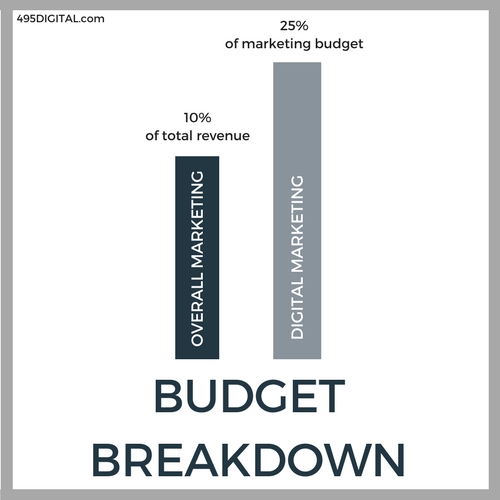
your digital marketing campaigns.
Overall Marketing Budget
According to the survey, most businesses allocate at least 10% of company revenues on various forms of marketing.
Digital Marketing Budget
According to the survey, the majority of today’s businesses spend over 25% of their total marketing budget on digital marketing.
Prioritizing Your Digital Ad Budget
The next step in figuring out how much you should spend is to figure out which part you will spend it on. Digital Marketing is a huge field and consists of many methods and strategies. Therefore, it is important for small business to narrow down the range of the most important aspects of digital marketing in order to spend their money wisely.
According to a recent marketing chart, successful B2B digital marketing campaigns over the last few years were mostly geared to generating leads and converting those leads. Basically, this equates to getting online traffic (visitors) and converting them to leads or sales.
There are three main digital marketing priorities that can accomplish these tasks:
- Digital Advertising
- Content Marketing
- Website Development & Design.
Digital Advertising: This consist of paid advertising mediums like Google Adwords, Facebook Ads, Twitter Ads, Youtube Ads, and a host of other social media and lesser-known platforms that offer Pay-Per-Click (PPC), Pay-Per-Impression (PPI), or a flat rate to show your ad for a specific time frame. This is the fastest way to generate traffic to your site but can be the most expensive as well.
Content Marketing: Content is still king online, therefore it is important to provide your visitors with engaging and relevant content that is provided free of cost (at first). This helps build trust and a long-lasting relationship which is the most important part of the conversion process. Engaging content includes blog articles, press releases, videos, infographics, and images.
Website Design/Development: Aside from being part of a well-rounded Search Engine Optimization (SEO) strategy, your website should be properly arranged for ease-of-use and conversion tactics. Once you have guided visitors to your site, engaged them with valuable content, you then want to make it easy for them to opt-into your prospect list and become a part of your sales funnel, which hopefully ends in a new customer.
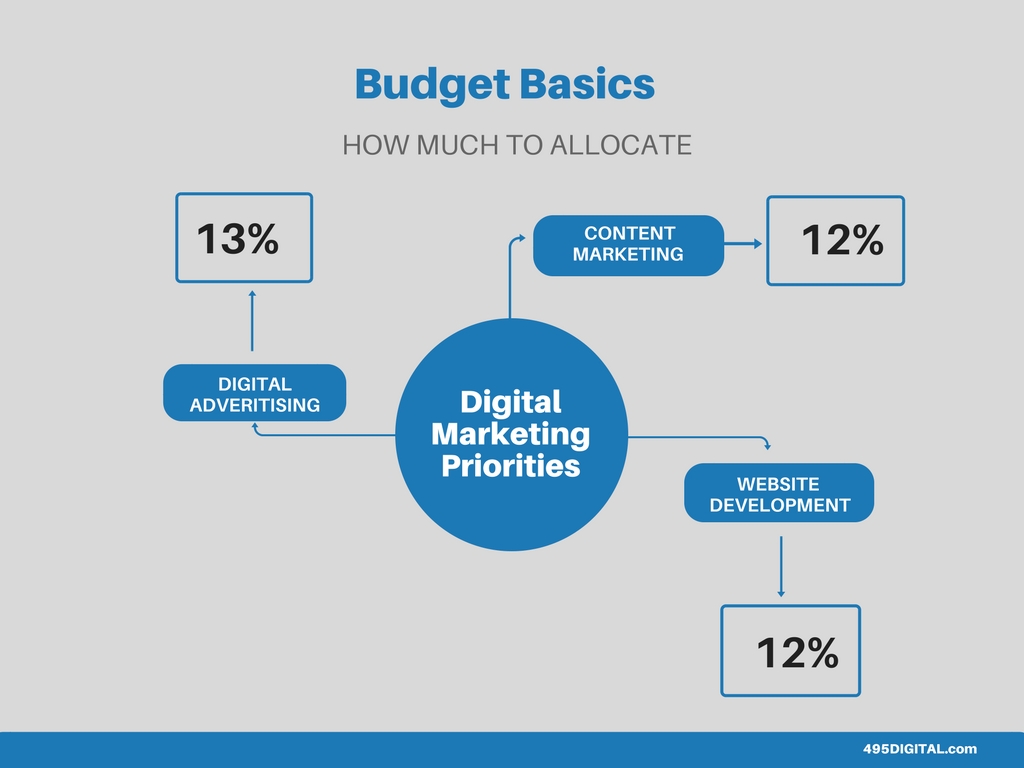 How Much To Allocate
How Much To Allocate
Now that you know how much to spend for your digital marketing campaigns (25% of 10% of revenue), as well as which areas of digital marketing to focus on first, we can now break down the percentages even further for each of the three main areas of digital marketing.
Here is the breakdown:
13% of your advertising budget should go to Digital Advertising.
12% of your advertising budget should go to Content Creation/Marketing.
12% of your advertising budget should go to Website Design/Development.
For example, in very simple terms, assuming you have an ad budget of $10,000 the allocated amount would look something like this:
Digital Advertising: $1,300
Content Creation/Marketing: $1,200
Website Design/Development: $1,200
Conclusion
Having a planned out budget for your digital marketing campaigns is essential for you and your small business to see a positive ROI. Allocating the budget through the 3 main categories listed above will ensure a continuous amount of customers/clients both now and well into the future.

The Best Way to Bypass Bot Traffic and Save Your PPC Campaign From Ruin
/0 Comments/in advertising, trending/by 495digital Bots are an ugly part of life for any organization doing business online. There are armies of them, crawling and clicking on ads, creating huge volumes of fake traffic.
Bots are an ugly part of life for any organization doing business online. There are armies of them, crawling and clicking on ads, creating huge volumes of fake traffic.
Advertisers lost an estimated $19 billion as a result bot fraud in 2018, according to Juniper Research (via Which-50.com). That’s the equivalent to $51 million a day.
With bots everywhere (and multiplying quickly), advertisers and online businesses alike must stand up and take note. No doubt it will take sophisticated ad technology and proven traffic-cleansing techniques to prevent bots from taking over, but there is something digital advertisers can do right now to buck the system.
No, we’re not talking about using a shady black hat work-around. We’re talking about a tried and true strategy that will bypass bots and save an advertising campaign from a sinking ROI.
More on this later. But first, some specifics.
The Deal With Bot Traffic
Bot traffic is a form of online ad fraud in which a nefarious individual or group of individuals uses automated software and scripts to drive artificial impressions or clicks. Normally, web traffic involves a visit from a human. With bot traffic, however, non-human computers trigger ad impressions and click ads; thus, costing advertisers big bucks.
 How Digital Ad Fraud Costs Advertisers Big Bucks
How Digital Ad Fraud Costs Advertisers Big Bucks
Bot traffic costs advertisers money in several ways.
If you promote your website on a pay-per-click (PPC) platform like Google AdWords, for instance, a competitor may drive up your advertising costs by sending bot traffic to your ads. Because they aren’t human visitors, bots won’t generate conversions or otherwise improve your return on investment (ROI). They will, however, inflate your advertising costs.
If you advertise on a cost-per-impression (CPM) platform, bot traffic can also cost your money. The websites on which CPM ads are displayed typically earn revenue based on impressions. As a result, some corrupt publishers will purchase bot traffic to inflate their impressions and earn more money. This is bad news for the advertiser who created the ad because he or she pays for low-quality bot traffic.
Signs You’ve Been Blasted by Bots
There are a few tell-tale signs of bot traffic, which one of which is an unusually high click-through rate (CTR) or impression count.
If your PPC ads suddenly have a 50 percent or higher CTR, you might be receiving bot traffic. Alternatively, generating 50,000 ad impressions on a website or channel that usually generates just 2,000 to 3,000 impressions could be a sign of bot traffic.
Scouring through your website logs can also reveal bot traffic. Assuming you have Google Analytics installed, check metrics like bounce rate and average view time. Bots typically visit the site and immediately leave, resulting in a high bounce rate and low view time.
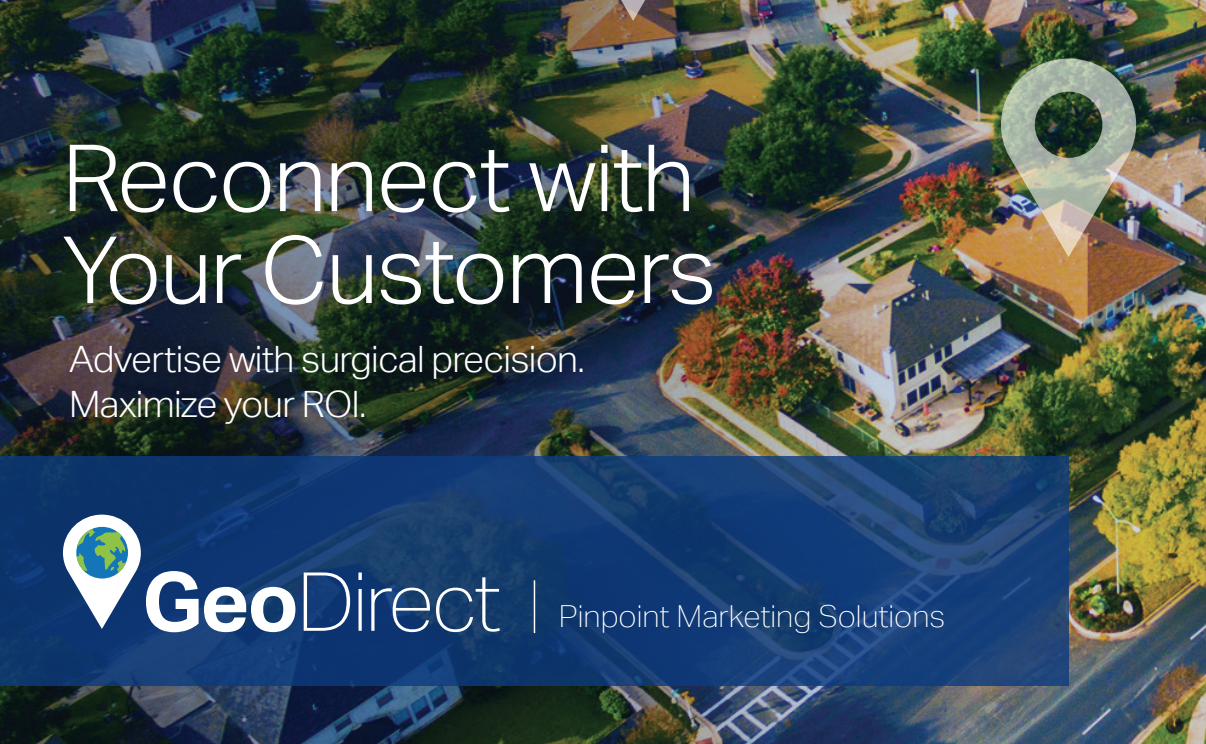 The Best Way to Win the War Against Bots and Boost Online Ad ROI
The Best Way to Win the War Against Bots and Boost Online Ad ROI
Beating online ad fraud, while complex, can be done. And quite easily too.
The process begins by harnessing the power of offline data.
We rely on a product called GeoDirect. It’s a patented IP targeting software that matches physical addresses with IP addresses offline, enabling advertisers to deliver their messages with surgical precision to the right person, at the right time.
Rather than casting a wide net over a targeted demographic or geographic location, and allowing the bot armies to attack, GeoDirect ad campaigns are directly targeted and delivered to predetermined households and audiences.
An ad campaign that’s launched under the helm of GeoDirect delivers results that speak (and pay) for themselves.
Did we mention that GeoDirect is also connected to all the major ad networks, and can deliver ads like:
- Display
- Text
- Native
- Video
Conclusion
Beating online ad fraud, like any other process for solving a complex problem, is an activity that involves constant analysis and learning from previous experiences. Using a disciplined methodology, like GeoDirect, with specific data parameters and corrective measures can help bypass bot traffic and give online businesses reassurance that they are getting their money’s worth.
About Us
495 Digital is a strategic branding and cross-channel marketing communications agency. We provide a full range of design, marketing, and advertising services including creative, strategy, content development, campaign implementation, and results reporting.
495 Digital, LLC
1308 Vincent Place
McLean, VA 22101




